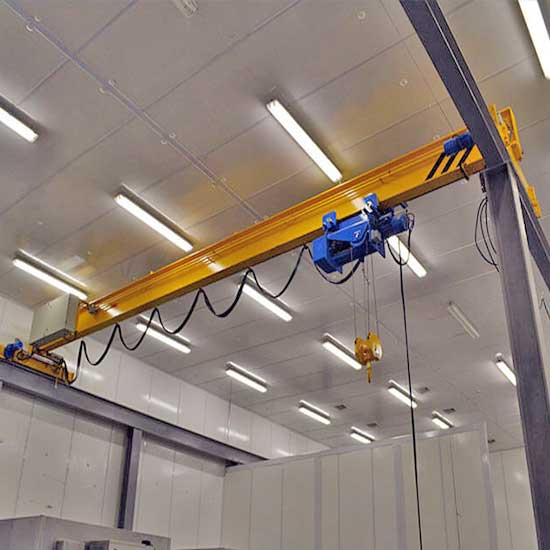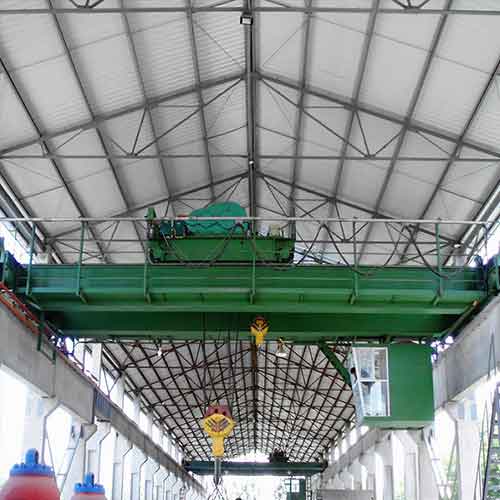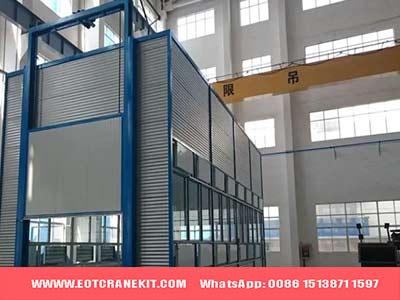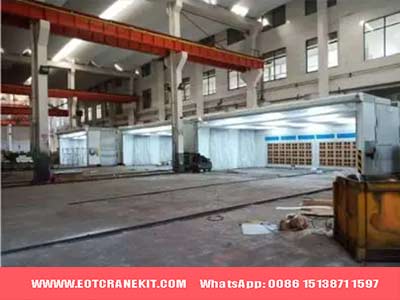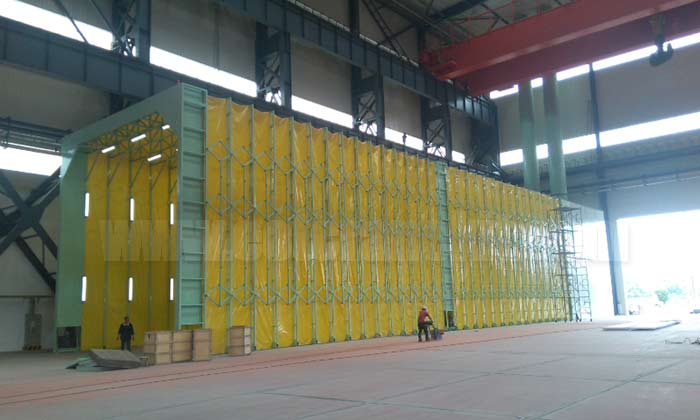
Explosion Proof Overhead Cranes for Paint, Spray & Finishing Booth
Overhead cranes for paint booth, with explosion proof crane features for painting workshops or both to improve safety & efficiency. Get paint booth crane,the Explosion Proof Overhead Cranes for Paint, Spray & Finishing Booth.
Introduction to paint booth crane
Paint booth Explosion proof overhead cranes are specialized lifting and material handling systems designed to facilitate the movement of components, products, and equipment within paint processing facilities, spray booths, and related environments. They play a crucial role in optimizing material handling processes, ensuring efficient, precise, and safe transfer of items throughout various stages of painting and finishing.
Paint booth bridge cranes are essential in addressing the unique challenges posed by paint processing, where precision, contamination control, and safety are paramount. These cranes are tailored to the specific requirements of the painting industry, offering solutions that enhance operational efficiency, quality, and overall productivity.
Main functions of paint booth explosion proof crane- Paint Spray booth eot cranes are custom-engineered systems used for lifting and handling materials in paint processing and spray environments.
- These cranes address the challenges of material movement in paint booths, ensuring precision, efficiency, and safety.
- paint booth electric cranes contribute to improved workflow, reduced paint contamination risks, and enhanced material handling accuracy.
Material Handling Precision:
Spray booth overhead cranes are engineered for precise material handling. They allow operators to position components or products with accuracy, ensuring that every surface receives the required coating evenly.
Compact Design:
These cranes are designed to fit within the limited space of a paint booth. Their compact structure minimizes interference with other equipment, walls, or structures present in the booth.
Corrosion-Resistant Materials:
Finishing booth bridge cranes are often constructed from materials that resist corrosion, as exposure to paint fumes and chemicals is common in such environments. This ensures the longevity and durability of the crane.
Explosion-Proof Features:
In environments where flammable paints or solvents are used, explosion-proof features can be incorporated into the crane's design to enhance safety and prevent potential hazards.
Versatile Configurations:
Paint booth remote control overhead cranes come in various configurations, such as bridge cranes, jib cranes, or monorail cranes. The choice of configuration depends on the specific requirements of the paint booth and the type of materials being handled.
Enclosed Wiring and Components:
To protect the crane's wiring and components from paint overspray and environmental contaminants, many paint booth top running overhead cranes feature enclosed systems that prevent debris from affecting the crane's operation.
Compliance with Industry Standards:
paint booth overhead travelling cranes are designed to comply with relevant industry regulations and safety standards, ensuring a safe and compliant working environment for operators and personnel.
Customization Options:
Each paint booth may have unique requirements based on the size, layout, and types of components being painted. Paint booth crane manufacturers often offer customization options to tailor the crane's features to match the specific needs of the facility.
In paint booth environments, where maintaining a controlled and clean painting process is essential, paint spray booth overhead cranes play a critical role in ensuring smooth material handling without compromising the quality of the painted surfaces. These cranes contribute to efficient workflows, reduced material wastage, and overall improved productivity within the painting and finishing industry.
Types of paint booth overhead cranes
Painting workshop overhead cranes come in various types, each tailored to specific material handling needs and environments. Here, we explore different types of paint booth overhead cranes and their unique features, benefits, and applications:

- Explanation: Bridge cranes consist of a horizontal bridge that moves along elevated runways. They offer excellent load-bearing capacity and a wide coverage area.
- Suitability: Bridge cranes are ideal for lifting and transporting heavy components within spacious paint booths.
- Features and Benefits: Bridge cranes facilitate the precise movement of large items, such as vehicle bodies or heavy machinery, between different painting stations. Their robust structure and precise controls enhance safety and efficiency.
- Applications: Automotive spray booths, industrial painting, large equipment or machinery painting.
- Introduction: Jib cranes feature a vertical mast with a horizontal jib arm that rotates around it. They excel in localized material handling within limited spaces.
- Suitability: Jib cranes are perfect for smaller paint booths and workshops where precise positioning is essential.
- Features and Benefits: Jib cranes provide efficient material handling solutions in confined spaces. They aid in positioning smaller components, tools, or equipment for accurate painting, reducing manual labor and increasing productivity.
- Applications: Furniture spray booths, localized painting tasks, compact manufacturing areas.
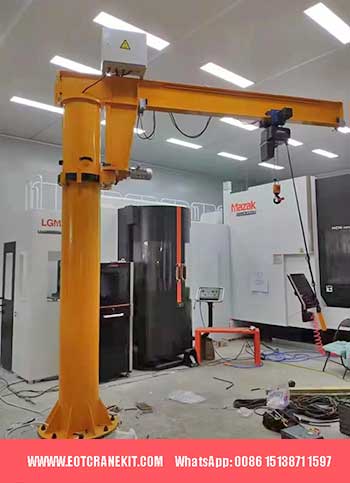
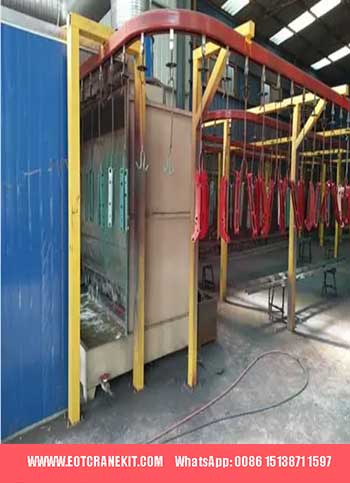
- Description: Monorail cranes have a single rail along which a trolley moves, facilitating linear material movement.
- Role: Monorail cranes streamline material flow along designated paths, enhancing efficiency in conveying components through various painting stages.
- Features and Benefits: Monorail cranes guide products through sequential painting, drying, and curing stages. They ensure consistent and controlled movement, optimizing batch processing.
- Applications: Batch painting booths, conveyorized painting systems, linear material movement.
Gantry Cranes:
- Overview: Gantry cranes feature a bridge supported by upright legs or columns and provide versatility in movement.
- Versatility: Gantry cranes are suitable for lifting and transferring heavy loads within spacious paint booths or outdoor painting yards.
- Features and Benefits: Gantry cranes handle large and heavy components, such as vehicles or industrial machinery, contributing to efficient material handling in various painting scenarios.
- Applications: Automotive spray booths, outdoor painting areas, heavy-duty painting tasks.


Articulating Jib Cranes:
- Definition: Articulating jib cranes have multiple pivot points, offering flexibility in positioning.
- Flexibility: Articulating jib cranes are ideal for accessing intricate or hard-to-reach areas that require precise painting.
- Features and Benefits: These cranes combine reach and accuracy, allowing components to be painted precisely, even in complex geometries.
- Applications: Paint booths with detailed designs, customized painting tasks, challenging spatial requirements.
In the subsequent sections, we will explore considerations for choosing and customizing paint booth overhead cranes to match specific requirements and operational needs.
Overhead cranes for different types of painting booth, spray booth and spray booth
Different types of painting booths, spray booths, and spray booths may require specific types of cranes based on their size, layout, and the tasks involved. Here's how different crane types can be suitable for various types of paint booth environments:
Automotive Spray Booths:
- Bridge Cranes: Automotive spray booths often handle larger components, such as vehicle bodies or heavy automotive parts. Bridge cranes are suitable for these spacious environments as they offer the strength and coverage needed to lift and transport these larger items efficiently. They can move heavy components between different painting stations and drying areas.
- Gantry Cranes: Similar to bridge cranes, gantry cranes are well-suited for automotive spray booths. They can handle heavy loads and are particularly useful when lifting and moving vehicles or large components to different painting stations.
Small-Scale Spray Booths:
- Jib Cranes: In smaller spray booths, space efficiency is key. Jib cranes provide localized material handling, making them ideal for positioning smaller components, tools, or equipment for painting. They require minimal space and can assist in precise material placement.
- Articulating Jib Cranes: Small-scale spray booths often have intricate or hard-to-reach areas that require precise painting. Articulating jib cranes offer flexibility in reaching challenging spots, ensuring that all areas of the smaller components receive an even coat of paint.
Batch Spray Booths:
Monorail Cranes: Batch spray booths involve a sequence of painting stages where components move from one station to another. Monorail cranes are designed for linear movement and can guide products along a fixed path, ensuring efficient movement between painting, drying, and curing areas. They contribute to streamlined batch processing.
Industrial Spray Booths:
Gantry Cranes: Industrial spray booths often handle larger industrial equipment or machinery. Gantry cranes are capable of lifting heavy loads and provide the strength and versatility needed for such tasks. They can efficiently move these substantial components for painting and finishing.
Furniture Spray Booths:
Jib Cranes: Furniture spray booths involve painting individual furniture pieces. Jib cranes are suitable for these scenarios, as they can assist in positioning furniture items for painting and transferring them between workstations with precision.
Aerospace Spray Booths:
Bridge Cranes: Aerospace spray booths deal with aircraft components or large parts that require careful handling. Bridge cranes are efficient for moving heavy materials within the facility, ensuring that aerospace components receive the necessary coatings accurately.
Clean Room Spray Booths:
Articulating Jib Cranes: Clean room environments demand strict cleanliness. Articulating jib cranes provide precise material placement while minimizing contamination risks, making them suitable for paint booths with stringent cleanliness requirements.
Automated Spray Booths:
Stacker Cranes: In automated spray booths, efficiency is paramount. Stacker cranes automate the material storage and retrieval process, optimizing space and ensuring that materials are managed before and after the painting process efficiently.
It's important to note that the selection of the right crane type depends on factors such as the weight and size of the components, the available space, safety considerations, and the workflow within the specific type of paint booth. Working with crane manufacturers who offer customization and expertise in tailoring crane solutions to specific requirements is crucial for optimizing material handling in painting and finishing environments.

Versatile Applications of Spray Booth Overhead Cranes
At our crane factory, we wholeheartedly acknowledge the distinctiveness of various industries in the realm of paint processing and finishing. Recognizing the unique demands that each sector presents, we've engineered our spray booth overhead cranes to seamlessly adapt to a diverse array of industries. This adaptability empowers us to cater to the specific material handling requirements and challenges that each industry faces. Let's embark on a journey to explore the dynamic integration of our cranes across various industrial applications, enhancing precision and efficiency every step of the way.
Automotive Industry: Precision in Lifting and Positioning Vehicle Bodies and Components
Within the fast-paced domain of automotive manufacturing, precision and speed are paramount. Our spray booth overhead cranes find their true calling within automotive paint booths, gracefully lifting and expertly positioning vehicle bodies, chassis, and components. Their ability to effortlessly manage substantial loads contributes to the seamless flow of operations, ensuring that each vehicle emerges with a paint finish that is nothing short of perfection.
- Automotive Industry: Precision in Automotive Paint Booths
- Typical Type: Bridge Cranes
- Features: High lifting capacity, smooth movement, precise positioning.
- Main Functions: Lifting and positioning vehicle bodies, components, and chassis.
- Typical Application: Ensuring flawless paint coverage on diverse automotive parts.
Furniture Manufacturing: Meticulous Placement of Furniture Items for Painting
Crafting exquisite furniture demands unwavering attention to detail, even during the painting stage. In this arena, our cranes play a pivotal role by delicately positioning each furniture piece, ensuring an impeccable coat of paint. Whether it's the intricate patterns of delicate woodwork or the fine details of elegant designs, our cranes ensure that every nook and cranny is adorned with flawless paint, enriching the aesthetics and value of the final masterpiece.
- Furniture Manufacturing: Artistry in Furniture Paint Booths
- Typical Type: Jib Cranes
- Features: Compact design, maneuverability, ergonomic handling.
- Main Functions: Precise placement of furniture pieces for thorough paint coverage.
- Typical Application: Enriching the beauty and value of fine furniture through impeccable painting.
Aerospace Sector: Exacting Precision in Handling Intricate Aircraft Components
The aerospace industry is renowned for its unyielding standards of precision and accuracy. Rising to the challenge, our spray booth overhead cranes exhibit finesse in handling intricate aircraft components. From engine parts to fuselage elements, our cranes ensure a uniform coating that contributes significantly to the safety and dependability of aerospace equipment.
- Aerospace Sector: Excellence in Aerospace Paint Booths
- Typical Type: Bridge Cranes
- Features: High load-bearing capacity, precision controls, anti-collision systems.
- Main Functions: Handling and positioning intricate aircraft components for uniform painting.
- Typical Application: Ensuring the safety and performance of aerospace equipment through meticulous coating.
Industrial Machinery: Robustly Lifting Heavy Machinery Parts for Painting
The realm of heavy machinery mandates solutions of substantial strength and durability. Enter our gantry cranes, perfectly tailored for the demands of the industrial machinery sector. With their robust capacity, these cranes expertly lift and position colossal machinery components, ensuring comprehensive and meticulous painting. Their unwavering strength and precision stand as guardians of the functionality and longevity of industrial equipment.
- Industrial Machinery: Power in Machinery Paint Booths
- Typical Type: Gantry Cranes
- Features: Heavy-duty construction, robust lifting capabilities, adaptability.
- Main Functions: Lifting and positioning hefty machinery parts for thorough painting.
- Typical Application: Enhancing the functionality and longevity of industrial equipment through comprehensive coating.
Batch Painting Facilities: Orchestrating Materials Through Sequential Processes
In facilities characterized by batch painting, a meticulous orchestration of sequential and controlled processes is the norm. Our monorail cranes excel in this role, adeptly guiding materials through the intricate dance of painting, drying, and curing stages. Their steadfast adherence to predefined paths ensures uniform and consistent paint application, orchestrating a seamless transition from one stage to the next.
- Batch Painting Facilities: Sequenced Precision in Batch Paint Booths
- Typical Type: Monorail Cranes
- Features: Linear movement, controlled transport, programmable paths.
- Main Functions: Guiding materials through sequential painting, drying, and curing stages.
- Typical Application: Streamlining the batch painting process with consistent and organized material handling.
Marine Industry: Vigilance in Marine Paint Booths
- Typical Type: Gantry Cranes
- Features: Corrosion-resistant materials, specialized coatings, marine-grade durability.
- Main Functions: Lifting and positioning marine components for protection against water and environmental elements.
- Typical Application: Safeguarding marine vessels and equipment through thorough paint coverage.
Electronics Manufacturing: Precision in Electronics Paint Booths
- Typical Type: Jib Cranes
- Features: Compact size, precise control, anti-static measures.
- Main Functions: Precise positioning of delicate electronic components for optimal painting.
- Typical Application: Ensuring quality and reliability in electronic devices through meticulous coating.
Heavy Equipment Industry: Strength in Heavy Equipment Paint Booths
- Typical Type: Gantry Cranes
- Features: High load capacity, durability, adaptable configurations.
- Main Functions: Lifting and placing large, heavy equipment components for thorough paint application.
- Typical Application: Enhancing the appearance and durability of heavy machinery through comprehensive coating.
In each industrial sector, the choice of paint booth overhead cranes showcases a commitment to excellence in paint processing. With a firm grasp of sector-specific challenges and requirements,Our crane factory delivers solutions that cater to your unique needs. Stay tuned as we explore the core concerns of users considering paint booth overhead cranes, guiding you towards an informed decision that aligns perfectly with your operational goals.
From the aerospace industry to automotive marvels, the intricate world of furniture, and the robust realm of heavy machinery, our spray booth overhead cranes gracefully traverse the diverse challenges that each sector presents. At our crane factory, we take immense pride in crafting solutions that transcend industry boundaries, elevating the art of material handling within the realm of paint processing. As we transition to the next section, we'll delve into the pressing concerns that prospective users of spray booth overhead cranes often grapple with, offering insights to illuminate their decision-making journey. Keep your curiosity piqued; there's more to explore!
Considerations for Choosing a Paint Booth Crane
Selecting the right paint booth crane involves a careful evaluation of various factors to ensure that the chosen crane aligns with the specific requirements of your paint booth environment. Here are the key considerations to keep in mind:
Weight and Size Requirements:
- Match the lifting capacity of the crane to the heaviest components you will handle in the paint booth.
- Ensure that the crane's capacity is sufficient to lift and move materials safely and effectively.
Paint Contamination Prevention:
- Opt for cranes with sealed components and enclosures to prevent paint overspray from affecting the crane's operation.
- Contamination control is crucial to maintain a clean and efficient paint booth environment.
Corrosion Resistance:
- Choose materials and coatings that are corrosion-resistant to withstand the chemical and paint fumes exposure within the paint booth.
- Corrosion resistance ensures the crane's durability and longevity in such environments.
Safety Standards:
- Ensure that the selected electric indoor overhead crane complies with relevant safety standards and regulations for the painting industry.
- Depending on the environment, consider explosion-proof features to mitigate fire hazards.
Integration with Paint Booth Systems:
- Evaluate the crane's compatibility with other systems within the paint booth, such as conveyors, automation, and drying equipment.
- Smooth integration enhances workflow efficiency and overall system performance.
Customization Options:
- Look for manufacturers that offer customization options to tailor the crane's features to the unique layout and processes of your paint booth.
- Customization ensures that the crane seamlessly meets your specific requirements.
Maintenance and Durability:
- Assess the maintenance needs of the crane, including access to components for servicing and maintenance requirements.
- A durable crane with manageable maintenance contributes to long-term efficiency and cost-effectiveness.
Budget Considerations:
- Compare the cost of the crane with its features and benefits to ensure it aligns with your budget.
- Consider the long-term return on investment the crane will provide through improved efficiency and reduced operational risks.
Considering these factors during the selection process will help you choose a paint booth crane that enhances material handling precision, operational efficiency, safety, and overall effectiveness within your paint booth or spray environment.
Why to be explosion proof crane design is used for painting workshops?
Painting booths or workshops often deal with volatile and flammable materials, such as paints, solvents, thinners, and other chemicals. These substances can release flammable vapors into the air, creating a potentially explosive atmosphere. In such environments, there is a significant risk of fire and explosion if proper precautions are not taken.
Explosion-proof cranes are necessary in painting booths or workshops for the following reasons:
- Ignition Source Avoidance: Regular cranes can generate sparks due to friction, electrical components, or mechanical interactions. In an environment with flammable vapors, even a small spark can ignite the air and lead to an explosion. Explosion-proof cranes are designed to minimize the risk of spark generation, ensuring that operations do not inadvertently trigger an explosion.
- Electrical Safety: Explosion-proof cranes are constructed with specialized materials, components, and wiring to prevent electrical sparks. This reduces the risk of electrical equipment causing ignition in the presence of flammable vapors.
- Enclosed and Protected Design: Explosion-proof cranes are enclosed to prevent the entry of flammable vapors, dust, or other hazardous substances into the crane's internal components. This design prevents these substances from coming into contact with any potential ignition sources within the crane.
- Safety in Hazardous Zones: Painting booths and workshops are often designated as hazardous zones due to the presence of flammable materials. Explosion-proof cranes are certified to operate safely in these hazardous zones without posing a risk of ignition.
- Compliance with Regulations: Many safety regulations and standards, such as those set by organizations like the Occupational Safety and Health Administration (OSHA) and the National Fire Protection Association (NFPA), require explosion-proof equipment in areas where explosive atmospheres are possible. Using explosion-proof cranes helps painting facilities comply with these regulations.
- Risk Reduction: By using explosion-proof cranes, the risk of fire and explosion in a painting booth or workshop is significantly reduced. These cranes are designed to prevent the initiation of explosions, ensuring the safety of workers, equipment, and the overall facility.
In summary, painting booths and workshops involve materials that can create an explosive atmosphere. Explosion-proof cranes are essential safety measures in these environments, as they are designed to prevent the generation of sparks and minimize the risk of fire and explosion, thus safeguarding both personnel and equipment.
Explosion proof features of overhead crane for painting both and workshops
Explosion-proof overhead cranes designed for painting booths and workshops incorporate various features and modifications to ensure the safety of operations in environments with flammable materials and volatile substances. Here are the key explosion-proof features of such cranes:
- Non-Sparking Components: Explosion-proof cranes are constructed using materials that reduce the likelihood of sparking due to friction or impact. Components such as wheels, hooks, and bearings are made from non-sparking materials like bronze or stainless steel.
- Enclosed Motors and Electrical Components: The motors and electrical components of explosion-proof cranes are enclosed in protective housings that prevent flammable vapors or dust from coming into contact with electrical parts. This design prevents electrical sparks from igniting the surrounding atmosphere.
- Sealed Electrical Connections: All electrical connections and wiring are sealed to prevent flammable gases or dust from entering the connection points and potentially causing sparks. This feature enhances the overall safety of the crane's electrical system.
- Explosion-Proof Enclosures: Electrical enclosures and control panels are designed to contain any potential explosions within the enclosure itself. These enclosures are constructed to withstand the pressure and heat generated by an explosion, preventing it from spreading to the surrounding environment.
- Surface Protection: The surfaces of explosion-proof cranes are coated with special finishes that prevent static electricity buildup. Static charges can be a source of ignition, so these coatings help dissipate any static charges that might accumulate on the crane's surface.
- Cable Protection: Wiring and cables are often covered with flame-retardant and chemical-resistant coatings to reduce the risk of ignition due to electrical faults or exposure to hazardous substances.
- Exhaust and Ventilation: Explosion-proof cranes are often equipped with exhaust systems or ventilation mechanisms that remove any flammable vapors or gases that might accumulate around the crane. This helps maintain a safer operating environment.
- Certification and Compliance: Explosion-proof cranes undergo rigorous testing and certification to ensure they meet specific explosion-proof standards and safety regulations. These standards are set by organizations such as ATEX (Appareils destinés à être utilisés en ATmosphères EXplosibles) and other regional or international regulatory bodies.
- Safety Devices: Additional safety features, such as overload protection, emergency stop buttons, and warning alarms, are often integrated into explosion-proof cranes to enhance overall safety and control during operations.
- Operational Training: Operators of explosion-proof cranes in painting booths and workshops receive specialized training to understand the potential hazards, safe operating procedures, and emergency response protocols in these sensitive environments.
In conclusion, explosion-proof overhead cranes for painting booths and workshops are designed with a combination of engineering, materials, and safety features to prevent the initiation of sparks, reduce the risk of fire and explosion, and ensure the safety of personnel and facilities in potentially hazardous atmospheres.
Customizing Overhead Cranes for Paint Booths
Customizing an explosion proof overhead crane for your paint booth involves tailoring the crane's features and specifications to match the unique requirements of your specific paint processing environment. To ensure a seamless integration and optimal performance, consider the following parameters for customization:
Paint Booth Layout:
- Provide detailed information about the dimensions, layout, and available space in your paint booth.
- Ensure that the crane's design aligns with the layout, allowing for efficient material movement and minimized obstructions.
Material Handling Requirements:
- Specify the weight range and size of the materials or components that the crane will handle.
- Customization ensures that the crane's lifting capacity matches your material handling needs accurately.
Type of Material:
- Detail the characteristics of the materials being painted, including their size, shape, and fragility.
- Customized features can include specialized lifting attachments or clamps designed for specific material types.
Process Workflow:
- Describe the sequence of painting and finishing stages that components go through in your booth.
- Customization can optimize the crane's movement and positioning to align with the sequential workflow, enhancing efficiency.
Safety Considerations:
- Identify any safety concerns unique to your paint booth environment.
- Customized safety features, such as explosion-proof mechanisms or proximity sensors, can be integrated to meet safety regulations.
Integration Needs:
- Determine if the crane needs to interface with other systems within the paint booth, such as conveyors or automated equipment.
- Customization ensures smooth integration, minimizing disruptions and optimizing overall system performance.
Future Adaptability:
- Consider potential changes to your paint booth setup or processes in the future.
- Opt for a crane design that can be easily modified or upgraded to accommodate evolving material handling needs.
Budget and Timeline:
- Provide budget constraints and project timelines for the customization process.
- Collaboration with crane manufacturers can help align customization options with your available resources and schedule.
Environmental Considerations:
If your paint booth is subject to specific environmental conditions, such as temperature extremes or humidity, communicate these factors for customized solutions.
Operator Ergonomics:
If your crane will be operated manually, consider ergonomic features that enhance operator comfort and reduce fatigue.
By addressing these parameters, you can collaborate effectively with crane manufacturers to create a customized overhead crane solution that optimally supports your paint booth operations. Customization ensures that the crane seamlessly integrates into your workflow, enhances material handling precision, and contributes to the overall success of your paint processing activities.
Parameters for Customized Overhead Crane:
When customizing an overhead crane for your paint booth, consider these parameters:
Paint Booth Layout:
- Provide detailed information about your paint booth's layout, including dimensions, available space, and any obstacles.
- Parameter needed to confirm your overhead crane : Crane span, Liffting height, and crane travelling length
Material Handling Requirements:
- Specify the weight and size range of components you'll be handling.
- Parameter needed to confirm your overhead crane : Crane rated capacity
Type of Material:
- Indicate the type of materials you'll handle, as this can impact the choice of materials for the crane's construction.
- Parameter needed to confirm your overhead crane : crane lifting devices
Process Workflow:
Describe your painting process, including the stages components go through, to determine the crane's optimal movement and positioning.
Safety Requirements:
Detail any safety considerations specific to your paint booth, such as explosion-proof features.
Integration Needs:
Discuss any systems the crane needs to integrate with, such as conveyor systems or other automation.
Future Adaptability:
Consider potential future changes to your operations and whether the crane can be modified or upgraded accordingly.
Budget and Timeline:
Provide your budget constraints and project timeline to ensure that the customized crane aligns with your resources and schedule.
By addressing these parameters and collaborating closely with crane manufacturers who have expertise in paint booth applications, you can ensure that the customized overhead crane meets your paint booth's unique requirements, enhances efficiency, and contributes to a successful painting process.
Benefits of paint booth explosion proof crane
Paint booth overhead cranes offer a range of significant benefits that contribute to the efficiency, safety, and overall quality of paint processing and finishing operations. Here are the key advantages that painting workshop use exproof overhead cranes bring to your paint booth environment:
Enhanced Material Handling Precision and Accuracy:
- Paint booth overhead cranes enable precise positioning of components, ensuring that every surface receives an even and accurate coating of paint.
- Accurate material handling results in consistent paint coverage, reducing the need for rework and enhancing the final product's quality.
Increased Efficiency in Material Movement and Workflow:
- Cranes streamline the movement of materials between different painting stations, reducing manual handling and minimizing process bottlenecks.
- Improved workflow ensures smoother operations, shorter cycle times, and enhanced overall productivity.
Improved Safety for Operators and Personnel:
- By minimizing manual lifting and handling, painting workshop explosion proof bridge cranes help reduce the risk of operator injuries and strain-related incidents.
- Safety features, such as anti-collision systems, contribute to a safer work environment for personnel.
Reduction of Paint Contamination Risks:
- Sealed components and enclosures prevent paint overspray from affecting the crane's operation and contaminating the paint booth environment.
- Contamination control ensures high-quality paint finishes and reduces the need for touch-ups.
Optimization of Space and Storage in Automated Settings:
- Automated systems like stacker cranes efficiently manage material storage before and after the painting process.
- Space optimization allows for organized storage of components and products, minimizing clutter in the paint booth.
Contribution to Consistent and High-Quality Paint Application:
- Precise material handling by cranes ensures that every part of a component receives uniform paint coverage.
- Consistent application leads to improved aesthetics, reduced wastage, and higher customer satisfaction.
Versatility in Handling Various Components:
- Different types of paint booth overhead bridge cranes cater to a wide range of material handling needs, from heavy components to intricate parts.
- The versatility of these cranes supports various painting tasks, accommodating different shapes, sizes, and weights.
Adaptability to Diverse Paint Booth Environments:
- Customizable features of painting workshop overhead eot cranes allow them to be tailored to specific paint booth layouts and processes.
- The adaptability of cranes ensures optimal performance regardless of the size or complexity of the paint booth environment.
By leveraging these benefits, paint booth operators can significantly enhance their material handling processes, reduce operational risks, and achieve consistent, high-quality paint finishes. painting workstation overhead cranes play a pivotal role in optimizing paint processing operations, contributing to increased efficiency, productivity, and customer satisfaction.
Case Studies and Real-world Applications
The successful paint booth crane operation across various industries underscore the positive impact of using the right crane type on operational efficiency, productivity, and overall outcomes. Here are some case studies that highlight these benefits:
Automotive Industry - Bridge Cranes:
- Scenario: An automotive manufacturer's paint booth handles large vehicle bodies and components that require precise positioning for optimal paint coverage.
- Solution: Bridge cranes are installed to lift and transport heavy automotive parts across different painting stations.
- Outcome: The use of bridge cranes significantly reduces manual labor, ensures accurate component placement, and speeds up the painting process. This results in improved production efficiency and consistent paint quality.
Furniture Manufacturing - Jib Cranes:
- Scenario: A furniture manufacturer operates a small-scale paint booth for painting individual furniture pieces.
- Solution: Jib cranes are installed within the booth to assist in positioning furniture items for painting and transferring them between workstations.
- Outcome: Jib cranes optimize the workflow by eliminating the need for manual lifting, enabling precise positioning, and reducing the risk of damage to delicate furniture pieces. This leads to increased productivity and improved final product quality.
Industrial Machinery - Gantry Cranes:
- Scenario: An industrial equipment manufacturer requires painting large and heavy machinery components.
- Solution: Gantry cranes are chosen for their strength and versatility in handling substantial loads.
- Outcome: Gantry cranes efficiently lift and move heavy industrial equipment within the paint booth. Their robust construction ensures safe material handling, reducing the risk of accidents and expediting the painting process.
Batch Painting Facility - Monorail Cranes:
- Scenario: A batch painting facility processes components through multiple painting, drying, and curing stages.
- Solution: Monorail cranes are implemented to guide products along a fixed path, optimizing material movement between different stages.
- Outcome: Monorail cranes ensure consistent and controlled material flow, minimizing errors and delays between painting processes. This results in streamlined batch processing and reduced cycle times.
Aerospace Manufacturing - Articulating Jib Cranes:
- Scenario: An aerospace manufacturer deals with intricate aircraft components requiring precise and uniform paint application.
- Solution: Articulating jib cranes are used to reach challenging areas and ensure accurate placement of paint.
- Outcome: Articulating jib cranes enhance the quality of paint application by allowing precise access to complex geometries. This leads to improved aesthetics, reduced rework, and increased customer satisfaction.
These case studies demonstrate how the selection of the appropriate paint booth crane type aligns with the unique needs of various industries, resulting in tangible benefits such as improved efficiency, enhanced safety, reduced wastage, and consistent paint quality. The right crane choice positively influences the overall success of paint processing operations, irrespective of the industry's specific requirements.
Unveiling the Answers: Paint Spray Booth Electric Overhead Bridge Cranes FAQs
Navigating the realm of paint spray booth electric overhead bridge cranes can sometimes raise questions and uncertainties. As dedicated providers of comprehensive solutions, we've compiled a collection of frequently asked questions to illuminate the path. Here, we shed light on common queries and concerns that potential buyers and users often encounter:
Are paint spray booth electric overhead bridge cranes customizable to our specific requirements?
Absolutely! Our bridge cranes are designed with customization in mind. From lifting capacity to control mechanisms and even special coatings, we tailor each crane to match your paint spray booth's unique dimensions and operational demands.
What safety features are integrated into your paint spray booth electric overhead bridge cranes?
Safety is paramount. Our cranes are equipped with advanced safety features, including anti-collision systems, overload protection, emergency stop buttons, and precision controls to ensure smooth and secure operations.
How do paint spray booth electric overhead bridge cranes contribute to paint quality and application?
Our cranes' precision and seamless movement guarantee uniform paint application. By facilitating accurate positioning of components, they minimize overspray and ensure a flawless finish, elevating the overall paint quality.
Can your cranes handle delicate or irregularly shaped items during painting?
Certainly! Our cranes are designed to handle a wide range of items, from intricate electronics to irregularly shaped industrial parts. With precise control and adaptability, they ensure meticulous paint coverage on diverse components.
What maintenance routines are needed for your paint spray booth electric overhead bridge cranes?
Maintenance is made easy. Regular inspections, lubrication, and ensuring proper electrical connections are essential. Our cranes are designed for accessibility, minimizing downtime and ensuring longevity.
Do your paint spray booth electric overhead bridge cranes integrate with other booth systems and automation?
Yes, they seamlessly integrate with various systems. Whether it's conveyor belts, drying equipment, or automated painting processes, our cranes are engineered to harmonize with your existing setup, enhancing overall operational efficiency.
What is the expected lifespan of your paint spray booth electric overhead bridge cranes?
With proper maintenance and care, our cranes are built to serve you for many years. We use high-quality materials and precision engineering to ensure the longevity of our cranes in demanding paint booth environments.
How can I ensure that the selected crane type aligns with my specific industry needs?
We understand the importance of making the right choice. Our experts are here to guide you. By understanding your industry, workflow, and requirements, we recommend the optimal crane type that ensures seamless material handling and exceptional results.
At our crane factory , we believe in fostering transparency and empowering informed decisions. If you have more questions or specific inquiries, don't hesitate to reach out. We're here to provide the insights you need to make the best choices for your paint spray booth electric overhead bridge crane solutions. In the upcoming section, we'll conclude our exploration with an invitation to partner with us on this journey towards operational excellence. Stay tuned!
Conclusion
Choosing the right paint booth crane is a critical decision that significantly impacts the efficiency, safety, and quality of paint processing and finishing operations. The careful selection of the appropriate crane type, customization options, safety considerations, and integration with other systems is essential for achieving optimal results within your paint booth environment.
By selecting the right crane type based on your specific requirements, you can unlock numerous benefits that include enhanced material handling precision, increased operational efficiency, improved safety for personnel, and minimized paint contamination risks. The optimization of space utilization, consistent and high-quality paint application, and adaptability to diverse material handling needs further underscore the value of well-chosen paint booth explosion proof crane.
It's essential to consider factors such as the type of paint booth, the materials being painted, the workflow sequence, safety standards, and future adaptability when customizing and selecting a crane. Collaboration with crane manufacturers and specialists can help align your needs with the crane's features, ensuring seamless integration and overall operational excellence.
In conclusion, the success of paint processing operations depends on the selection of the right paint booth crane that aligns with your specific requirements. By prioritizing the right crane type, customization options, safety measures, and integration strategies, you can create an efficient, safe, and productive paint booth environment that consistently delivers high-quality paint finishes and enhances overall business success.
